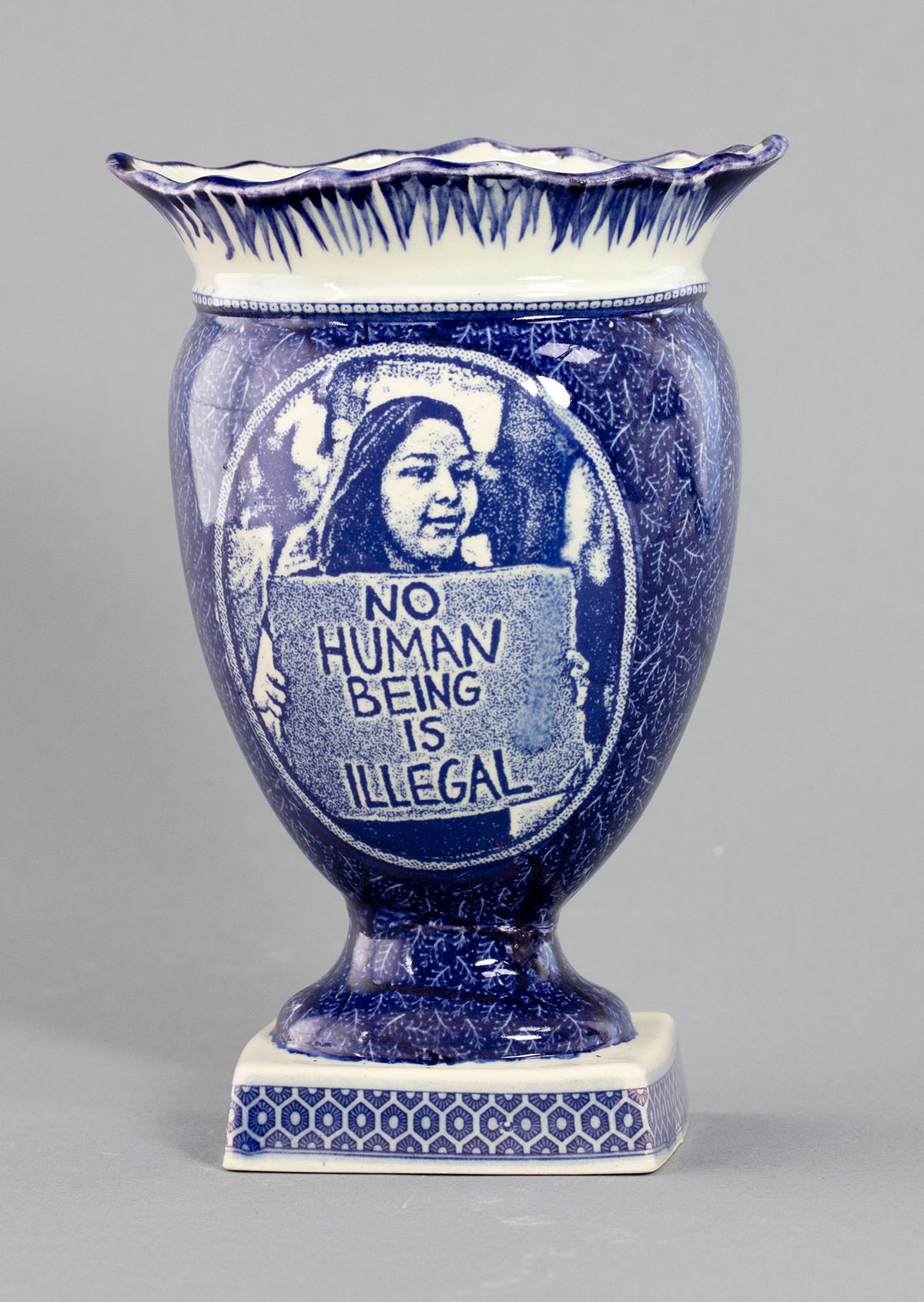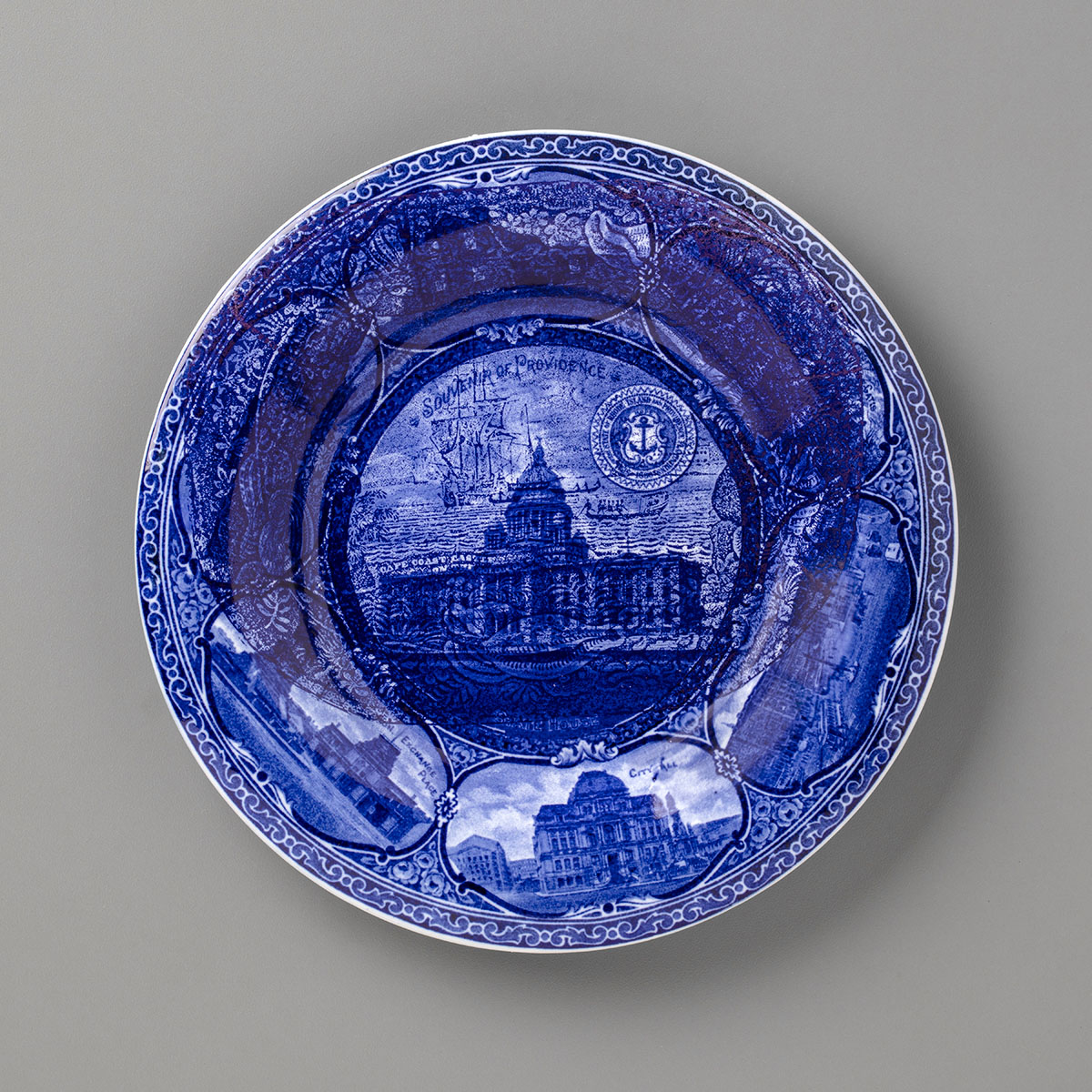- Art
- Exhibitions
- What, Me Worry? The Art and Humor of MAD Magazine
- Recall. Reframe. Respond. The Art of Paul Scott
- Rediscovered Treasures
- Special Features
- Upcoming Exhibitions
- Past Exhibitions
- Online Exhibitions
- Explore the Collection
- Provenance and Cultural Property
- Conservation
- Meet the Curators
- Digital Resources
- Art Bridges Cohort Program
Community Voice Responses
David V. Oxner III is a Cincinnati-based poet and art curator whose multidisciplinary practice bridges the spoken word and contemporary visual arts . . . . His dual focus on poetry and curation reflects a unique commitment to participatory and experiential art, shaping inclusive spaces where words and visuals engage in meaningful interplay.
“What the Plate Remembers”
In response to the exhibition Recall. Reframe. Respond. The Art of Paul Scott
They only see the blue
until the smoke curls up the edge—
until a wall cuts through a village scene
and a family becomes
a motif in exile.
These dishes once whispered
of peace and porcelain,
of manicured fields
and obedient rivers.
But you—
you asked them to speak plainly.
You held their silence to the fire,
scraped the glaze
from America’s cheekbones
and found
a buried pipeline,
a garden grown from ghost towns,
a sky
that no longer asks permission to burn.
Your hands do not decorate,
they declassify.
A floral rim gives way
to border patrol.
A pastoral bridge
becomes a fracture line
between what was promised
and what was practiced.
And somehow,
in this breaking,
in the mending,
in the gold that does not hide
but highlights the wound—
there is beauty.
Not because it was beautiful,
but because it was real.
Because it dared to say:
this, too,
is America.

Poetchii is an 18-year-old graduate from Mt. Healthy High School who was the regional finalist of the national competition Poetry Out Loud in 2024.
Golden Pieces
In response to Fukushima, No. 11
I want to educate you about the golden value of a precious antique,
But let me tell you why this precious antique is so unique,
When a plate breaks, that doesn’t stop it from being any less golden,
Every image on the plate told a story that made it more chosen,
As it’s in pieces, think of the meaning,
I see lonely houses that need some healing,
Because some way. . .
Somehow. . .
The waves washed away all their feelings,
With lovebirds all around it,
All the hurt souls that surround it,
Where the pleasure is laughter,
But the sorrow is madness,
As the water gets louder,
By any means, it’s still a part of a village,
When it cracked,
It took that plate away from being whole again,
Didn’t make it any less beautiful
When it was put back together,
It was gold again,
For some reason, I feel an Intermediate connection,
Admiring the plate, it teaches me so many lessons,
That reminds me I need to grow from the aggression,
Always count my blessings,
Like those houses,
I am still standing,
We all know, it takes a village to make a home feel like family.

Norman Riggs Jr. is a dynamic teacher, spoken word coach, and activist whose influences come from the Civil Rights Movement.
The Plate of Life
In response to Forget Me Not, Extinct, No. 1
Many similarities,
Yet many differences stand out.
Is one better than the other,
Because of his color?
Or does one soar higher
Or longer than others?
Why does the golden trail of extinction
Lead to another?
Is that the path that leads to one’s demise
As a culture?
Or is the Plate of Life cracked
Causing separation?
The Plate of Life—
The destruction of my people.
With targets on their backs,
Decreasing our population.
Do we deserve so much hatred?
Your dream is not our revelation.
The golden trail of extinction is not our future.
We will live on generation to generation.

MoPoetry Phillips is the president of Arts Equity Collective and co-founder of Regal Rhythms Poetry LLC. Her passion is to unite artists for a greater impact within the community.
ILL Legalization: The Sick Times We Are Living In
In response to Posy Vase, No. 2, No Human Being is Illegal
You want to protect our borders?
Show me the red, white, and blue,
I’ll show you the borders
To lands you stole that you migrated to.
It’s disingenuous to run others back to their homes.
If everyone except the Indigenous had to leave,
We’d ALL be gone—
Back to our foreign homes.
How ironic,
We have squatter’s laws
To give others the right to live in places
Where they don’t pay mortgage, or rent
Yet, the US proudly used slave labor to build this nation
Along with the labor of immigrants.
Can the US ever be our home?
All the time we’ve been here,
We’ve been forced into an unsure position.
Told to go back where we came from—
But only Black and Brown people are facing eviction.
“No Human Being Is Illegal,” it reads,
But what could be more illegal?
Perpetuate violence and mistreat law abiding citizens
Round up,
Separate families,
Even a mother and father . . . . . . . . . . . . . . . . . . . . . from their own child,
Because we refuse to see them as equal.
These are sick times we are living in!
We lack common respect for people.
This just another slavery sequel.
Homer Shadowheart
In response to Posy Vase, No. 2, No Human Being is Illegal
This is a very poignant piece at this point in history. First, it is beautiful in both appearance and message, and it speaks to the fact that we are all living on stolen land, so how can a human being be illegal while living on land that was stolen from the original occupants? To me this is a powerful piece of art, which needs to be seen now more than ever.
Arlene de Silva
In response to Posy Vase, No. 2, No Human Being is Illegal
Paul Scott’s art speaks to me at many levels. I was born in Sri Lanka (an island nation in South Asia) and have lived in the US for more than two thirds of my life. As an immigrant, I have great admiration for his work which portrays the tension, challenges, and beauty of a global community. He reminds us that we are one!
His artwork Posy Vase, No. 2, No Human Being Is Illegal, sadly reminds me of what America now stands for. As a young twenty-something in the late seventies, the United States was a friendly, welcoming, and full-of-opportunities nation. I came to Cincinnati on a short visit but the warmth of the people, and people willing to take a chance on me with job opportunities made me stay. The short stay has now become over 45 years.
As I look at Paul Scott’s Posy Vase. . . I’m reminded of the horrors immigrants and refugees face across the nation and in our own city. Through my work as a nonprofit leader, our organization has provided wellness services to immigrants and refugees for nearly fifteen years. These individuals have faced trauma and persecution in their homelands and arrive in the US in search of peace and a better life. Resettling in the US, the land of opportunity, gave them hope.
The artwork Posy Vase, No. 2, No Human Being Is Illegal, reminds me of where we’ve come to and what we’ve become as a nation.

Lisa Marie Holliman is a poet, visual, and teaching artist from Covington, Kentucky, known for her powerful stage performance and wordplay.
Disrupted Nostalgia
In response to Flint, near Detroit, No. 4
Irregular china
On display
No bones on the plate
Only the water
That can’t be drank’
Pastural florals
Flower portal
Blemish intentional
A radial blue blur
cultural erasure
Or an inclusion of cityscapes
Recontextualized
Like the high life met real time
Is there a hidden story?
In the phantasmal cobalt watercolor
Burned into bone ware
The tension between function and symbolism
The starving location of an urban dinner
No flower or scar
There’s a hunger on this plate
No helping could fill
A juxtaposed consumption
That bridges chinoiserie
And an American scene
Is it sanitized by its brightness
Or has it made tradition beautifully dirty?
It’s disrupted nostalgia
A chiasma of the two doves
Nested in a willow tree
It’s just as forbidden as the lore of lovers
A bone plate that will never see a bone cleaned
Art that reflects a time to sit
And extract nutriments of thought
From its display

David V. Oxner III is a Cincinnati-based poet and art curator whose multidisciplinary practice bridges the spoken word and contemporary visual arts . . . . His dual focus on poetry and curation reflects a unique commitment to participatory and experiential art, shaping inclusive spaces where words and visuals engage in meaningful interplay.
“Fragments in Blue”
In response to Broken Treaties, Standing Rock, No. 1 (after Defend the Sacred by Ryan Vizzions, with Mega May Plenty Chief, Lakota Oyate on horseback)
Some say porcelain remembers—
every crack, a covenant
between what broke
and what endured.
You, the surgeon of souvenir,
scalpel in hand,
cut through nostalgia’s gloss
and found a scream
buried in willow trees
and teacup skies.
America,
viewed through cobalt eyes,
still curtsies in pastoral plates,
while smoke from Standing Rock
rises like a prayer
on bone-white china.
A boy touches a border
that wasn’t painted there before.
Now it is.
Now we see.
You don’t break the plate—
you reveal it.
You hold empire’s polite veneer
up to the light
and show us
where the kiln failed,
where the heat kissed too close
to the truth.
You lace protest in scrollwork,
place injustice in a border.
And when gold repairs the break,
it’s not to heal the harm,
but to remind us
we cracked it.
We still do.
Your work is a mirror
we didn’t know we owned—
set delicately on a dining table
where we once passed
sugar,
and silence.

Ryan Nichole Leary, a Cincinnati native, is a multifaceted creative with over 20 years in visual art, art history, art education and spoken word performance.
Not Broken, Not in pieces
In response to Souvenir of Providence, Cape Coast Castle
Called my agya the best Okyeame of our people
As his daughter, learning our history, narratives
Memorizing all of the greats
For me, was a heavy plate.
Tried remembering the sweet scent of yesterday.
Tongue fumbling in my mouth to recall taste,
It is dank, damp, cramp, weary space;
I smell our stories swirling in this cage place
Ɛnmmu
It is not broken, not in pieces
Our story is not fragments, papa said
Their words sound like a fluster of Ibises
Dutch, Danish, Portuguese, Swedish,
Sounds like hostile drums
We look at each other, will we remember our tongue?
Ɛnmmu
I am not broken, not in pieces
We disembark of the Island of Rhode
My story in New Port, Bowen’s Wharf
Chipped away, cracked cold soul
Like a porcelain plate, 30 pds, I was sold.
Years passed, I worked in a place called Brown
My life barren, womb had been full
My children and their children run around
Dey ask me mamme, where we from?
I can still smell the warmth of the land
Taste the sweetness of our laughs
recall the stories of our seasons. . .
Ɛnmmu
We are not broken, We are not in pieces.






